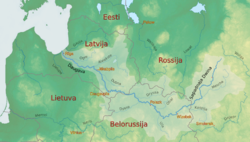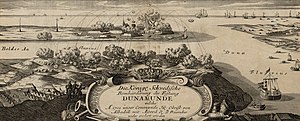Daugava
| Daugava Western Dvina | |
|---|---|
 The drainage basin of the Daugava | |
| Native name |
|
| Location | |
| Country | Belarus,Latvia,Russia |
| Cities | |
| Physical characteristics | |
| Source | Valdai Hills |
| • location | Penovsky District,Tver Oblast,Russia |
| • coordinates | 56°52′16″N32°31′44″E/ 56.871°N 32.529°E |
| • elevation | 221 m (725 ft) |
| Mouth | Gulf of Riga |
• location | Riga,Latvia |
• coordinates | 57°3′42″N24°1′50″E/ 57.06167°N 24.03056°E |
• elevation | 0 m (0 ft) |
| Length | 1,020 km (630 mi)[1] |
| Basin size | 87,900 km2(33,900 sq mi)[1] |
| Discharge | |
| • average | 678 m3/s (23,900 cu ft/s) |
 | |
TheDaugava(Latgalian:Daugova;Polish:Dźwina;German:Düna) orWestern Dvina(Russian:Западная Двина,romanized:Zapadnaya Dvina;Belarusian:Заходняя Дзвіна;Estonian:Väina;Finnish:Väinäjoki) is a large river rising in theValdai HillsofRussiathat flows throughBelarusandLatviainto theGulf of Rigaof theBaltic Sea.The Daugava rises close to the source of theVolga.It is 1,020 km (630 mi) in length,[1]of which 352 km (219 mi) are in Latvia[2]and 325 km (202 mi) in Russia. It is a westward-flowing river, tracing out a great south-bending curve as it passes through northern Belarus.
Latvia's capital,Riga,bridges the river'sestuaryfour times. Built on both riverbanks, the city centre is 15 kilometres (9.3 mi) from the river's mouth and is a significant port.
Etymology
[edit]
According toMax Vasmer'sEtymological Dictionary,thetoponymDvina cannot stem from aUralic language;instead, it possibly comes from anIndo-Europeanword which used to meanriverorstream.[3]The nameDvinaresembles stronglyDanuviuswhich itself derived from the Proto-Indo-European*dānu,meaning "large river".
The Finno-Ugric namesVēna(Livonian),Väinajogi(Estonian), andVäinäjoki(Finnish) all stem from Proto-Finnic*väin,meaning "a large, peacefully rolling river".
Geography
[edit]The totalcatchment areaof the river is 87,900 km2(33,900 sq mi), of which 33,150 km2(12,800 sq mi) are in Belarus.[1]
Tributaries
[edit]The following rivers are tributaries to the river Daugava (from source to mouth):
- Left:Mezha,Kasplya,Dysna,Laucesa,Berezauka,Eglona,Pikstere,Ņega
- Right:Usvyacha,Palata,Drysa,Dubna,Aiviekste,Pērse,Dīvaja,Ogre
History
[edit]
Humans have settled at the mouth of the Daugava and along the shores of the Gulf of Riga for millennia, initially participating in a hunter-gatherer economy and utilizing the waters of the Daugava estuary for fishing and gathering. Beginning around the sixth century CE,Vikingexplorers crossed the Baltic Sea and entered the Daugava River, navigating upriver into the Baltic interior.[4]
In medieval times, the Daugava was part of thetrade route from the Varangians to the Greeks,an important route for the transport of furs from the north and ofByzantinesilver from the south. The Riga area, inhabited by theFinnic-speakingLivs,became a key location of settlement and defence of the mouth of the Daugava at least as early as the Middle Ages, as evidenced by the now destroyed fort atTorņakalnson the west bank of the Daugava in present-day Riga. Since the Late Middle Ages, the western part of the Daugava basin has come under the rule of various peoples and states; for example, the Latvian town ofDaugavpilsvariously came underpapal,Slavonic, Polish, German, and Russian rule until therestoration of the Latvian independencein 1990 at the end of the Cold War.[citation needed]
Settlements
[edit]
The following are some of the cities and towns built along the Daugava:
Russia
[edit]Belarus
[edit]- Ruba
- Vitebsk
- Beshankovichy
- Polotsk(home to theBoris stones)
- Navapolatsk
- Dzisna
- Verkhnedvinsk
- Druya
Latvia
[edit]Environment
[edit]
The river began experiencing environmental deterioration in the Soviet era due to collective agriculture (producing considerable adverse water pollution runoff) and hydroelectric power projects.[5]This is the river that theVula riverflows into.
Water quality
[edit]Upstream of the Latvian town ofJekabpils,the river'spHhas a characteristic value of about 7.8 (slightalkaline). In this area, the concentration of ionic calcium is around 43 milligrams per liter,nitrateis about 0.82 milligrams per liter, ionicphosphateis 0.038 milligrams per liter, and oxygen saturation is 80%. The high nitrate and phosphate load of the Daugava has contributed to the extensive buildup of phytoplankton biomass in the Baltic Sea; theOderandVistularivers also contribute to the high nutrient loading of the Baltic.[citation needed]
In Belarus, water pollution of the Daugava is considered moderately severe, with the chief sources being treated wastewater, fish-farming, and agricultural chemical runoff (such as herbicides, pesticides, nitrates, and phosphates).[6][7]
References
[edit]- ^abcd"Main Geographic Characteristics of the Republic of Belarus. Main characteristics of the largest rivers of Belarus".Land of Ancestors.Data of the Ministry of Natural Resources and Environmental Protection of the Republic of Belarus. 2011. Archived fromthe originalon Jan 15, 2014.Retrieved27 September2013.
- ^"Gruberts D." Daugava ". Nacionālā enciklopēdija".Nacionālā enciklopēdija.Retrieved11 August2022.
- ^Фасмер, Макс.Этимологический словарь Фасмера(in Russian). p. 161.
- ^
Compare:
Frucht, Richard C. (2005-01-01).Eastern Europe: An Introduction to the People, Lands, and Culture.ABC-CLIO.ISBN9781576078006.Retrieved2017-07-06.
The Daugava was an important transit river (carrying everything from Vikings to floating lumber) for centuries [...].
- ^C.Michael Hogan (2012)."Daugava River".Encyclopedia of Earth.National Council for Science and the Environment.
- ^Towards water security in Belarus: a synthesis report.OECD Studies on Water. 2020. pp. 19–20.doi:10.1787/488183c4-en.ISBN9789264583962.Retrieved27 June2021.
{{cite book}}:|website=ignored (help) - ^"Water Report 15".fao.org.Food and Agriculture Organization of the United Nations.Retrieved27 June2021.
Further reading
[edit]- Richard C. Frucht; Aldis Purs (2005).Latvia.ABC-CLIO.p. 115.ISBN9781576078006.Retrieved2009-08-01.
{{cite book}}:|work=ignored (help) - Francis W. Carter and David Turnock. 2002. Environmental problems of East Central Europe. 442 pages Google eBook
- Kropotkin, Peter Alexeivitch;Bealby, John Thomas (1911)..Encyclopædia Britannica.Vol. 8 (11th ed.). p. 738.
